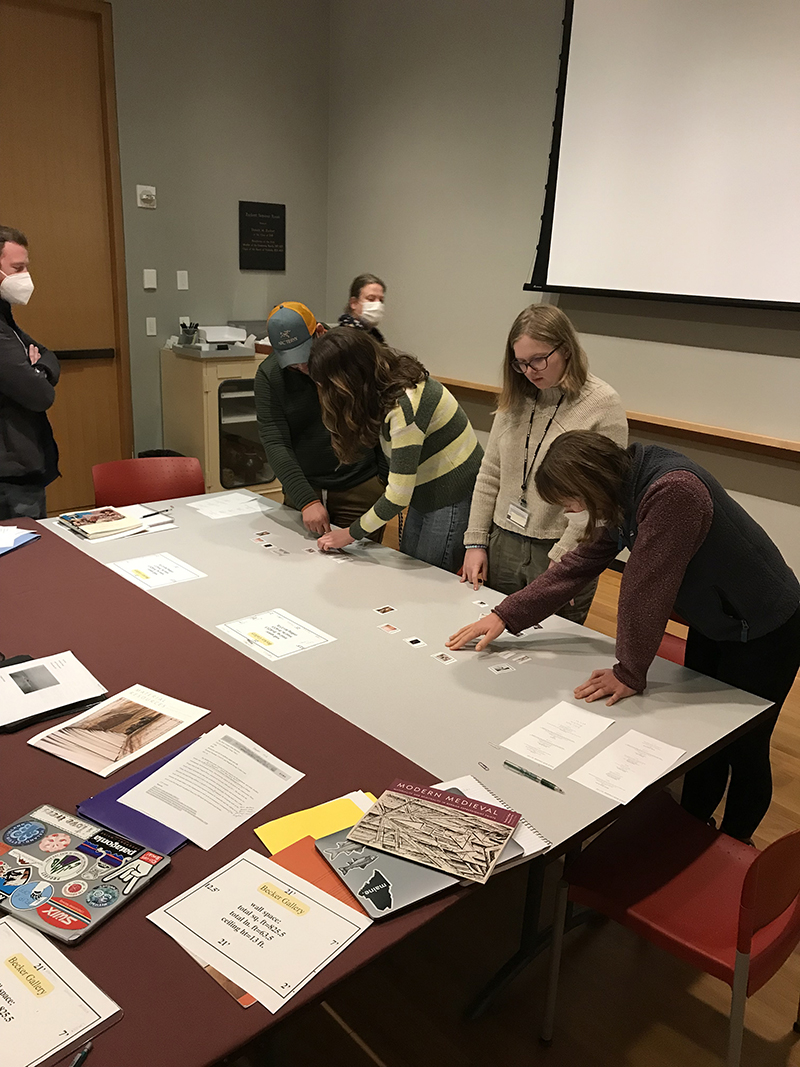Students Organize Exhibition at Bowdoin College Museum of Art
By Bowdoin College Museum of Art
Environmental Studies students planning the exhibition during a class in the Museum in the fall of 2022.
The Museum is pleased to announce the opening of Human Nature: Environmental Studies at 50 on March 16, an exhibition organized by five student majors in the Environmental Studies (ES) Program. It will continue on view through June 4, 2023. This exhibition, developed over course of the Fall 2022 semester, draws on the BCMA’s collection to investigate some of the timely issues and major questions that occupy students in Environmental Studies here at Bowdoin and across the discipline more broadly. Working with Matthew Klingle, associate professor of history and environmental studies, the five student co-curators— John Auer ’23, Tess Davis ’24, Sophia Hirst ’24, Hayden Keene ’23 and Brandon Lozano-Garay ’24— sought out works of art that reveal the complexities of living in a world shaped by humans, one that nevertheless exceeds our control. As Klingle notes, “environmental problems are complicated and involve many competing stakeholders.” The exhibition takes on those complexities, resisting the notion that nature should be represented a certain way and interrogating who is included in and excluded from definitions of what is “natural.”
In the spring of 2021, Connie Chiang, professor of history and environmental studies and director of the Environmental Studies Program, reached out to BCMA Co-Directors Anne Collins Goodyear and Frank Goodyear to propose a project at the Museum celebrating the upcoming fiftieth anniversary of Bowdoin’s ES Program. A partnership between the two College units seemed a fitting choice. In the summer of 2022, Klingle agreed to take the lead on the project. Klingle has been involved in previous exhibitions, and ES instructors frequently bring their classes to the Museum.
The BCMA also played a significant role in the early history of the Program: in 1966 Bowdoin faculty member John McKee mounted an exhibition of photographs titled As Maine Goes: The Maine Coast and Its Despoilment. The exhibition made both state and national headlines and featured a catalogue introduced by Supreme Court Justice William O. Douglas. It served as a springboard for legislative change in the state. McKee in turn went on to be one of the founding faculty members of the ES Program in 1972.
The students were selected mainly on a volunteer basis with the primary stipulation that they be ES majors. Each one brought different perspectives, which were often rooted in their diverse academic interests. In addition to Environmental Studies, the students contributed expertise in Art History, Gender, Sexuality, and Women’s Studies, English, Economics, and Chemistry. They were joined at the start of the Fall semester by the new BCMA Curator Casey Braun and the new Postdoctoral Curatorial Fellow Sean Kramer. During several visits to the Museum throughout the semester, Casey and Sean helped pull artworks from storage for the students to examine. During these sessions, conversations ranged from practical topics such as the exhibition checklist, layout, and paint colors, to heady philosophical ruminations about subjects like the Sublime in art.
Given the interdisciplinary nature of ES at Bowdoin, it was important that the exhibition draw on a wide range of campus collections. In addition to their work at the BCMA, the students also consulted regularly with Genevieve LeMoine at the Peary-MacMillan Arctic Museum and Arctic Studies Center and Marieke van der Steenhoven at the George J. Mitchell Department of Special Collections & Archives. As such, the exhibition is as much an investigation into humanity’s fraught relationship with the environment—itself an ambitious topic!—as it is a demonstration of how learning happens at Bowdoin. Human Nature is the product of research, collaboration, compromise, and experimentation, which students from varying backgrounds built together. They worked as a team while still holding to their individual perspectives, not always sure what the end result would be. For several of the students, this was their first time researching and writing about art. For all of them, this was their introduction to the collaborative nature of museum work as well as the surprisingly difficult task of writing museum labels.
Make sure to check out Human Nature: Environmental Studies at 50 during your next visit to the BCMA! Also, stop by the Second Floor Gallery at Hawthorne-Longfellow Library to see Woods, Water, World: Environmental Studies at Bowdoin College, another student-driven project examining the prominent role the natural world has played at the College through archival documents, photographs, maps, and more.
Sean Kramer
Andrew W. Mellon Postdoctoral Curatorial Fellow
Bowdoin College Museum of Art